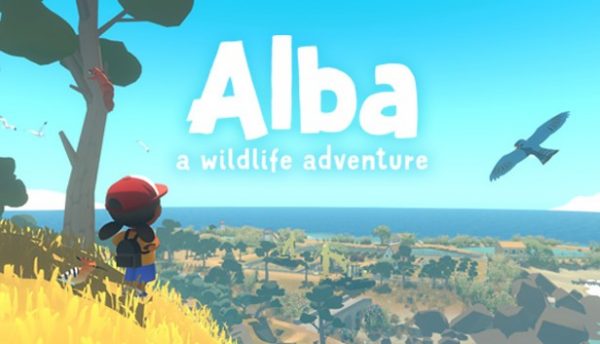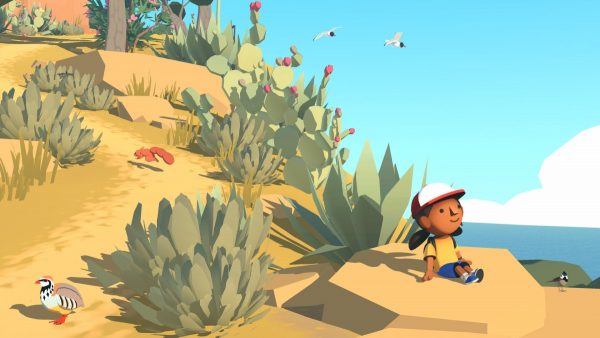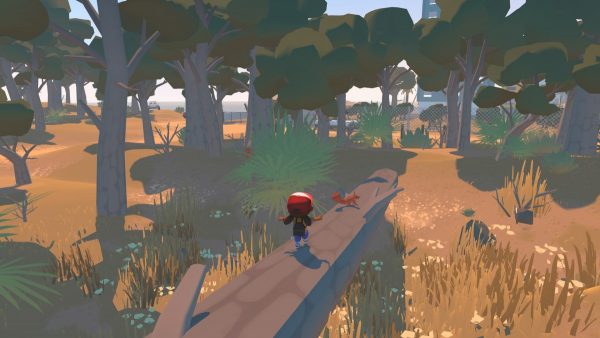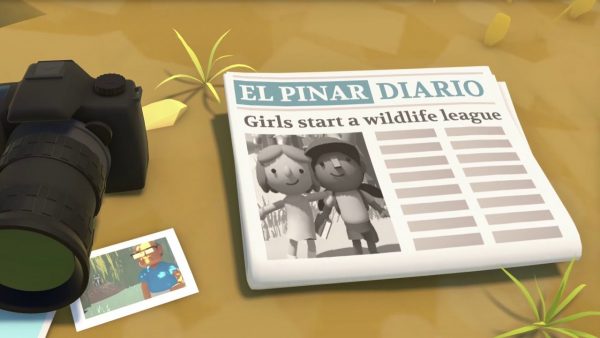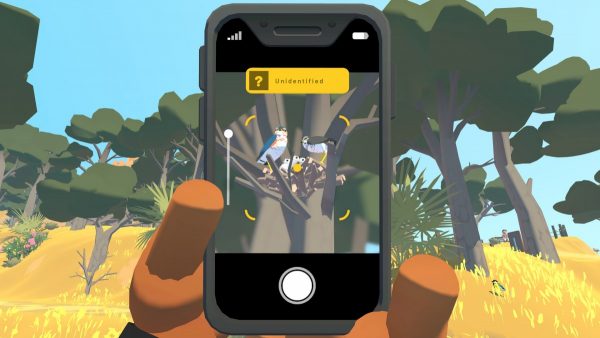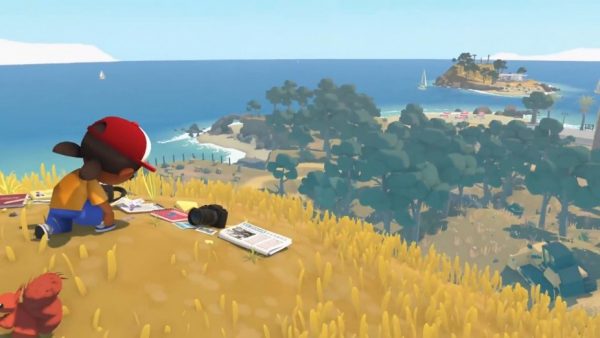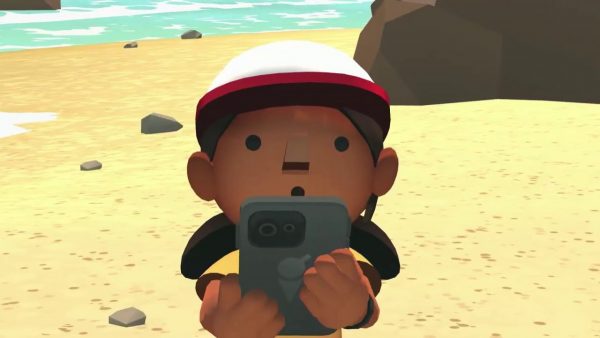Red Stewart reviews Alba: A Wildlife Adventure for PC (Steam)…
There’s something about animal photography that strongly stirs me. Perhaps it’s because I grew up reading nature catalogues, flipping through page after page of colorful creatures beautifully captured by some talented photographer. Ads for Zoo Books enchanted me, EyeWitness encyclopedias were checked out from the library, and every other week I found myself playing NabiscoWorld’s two “video safari” games (anyone else remember that amazing site?). Any chance I could get to see visceral images of fauna in their habitats I immediately took.
It should come as no surprise, then, that I was instantly enthralled by the concept behind Alba: A Wildlife Adventure. Developed and published by ustwo games, Alba sets you on an island of 61 animals and tasks you with helping save their home. Yet, in going the open-world route, I feel the game makers ultimately lose the charm they are trying to maintain. That’s the short answer, for the longer one read on.
We’ll begin with the story- you play as a young girl named Alba who is spending a summer vacation with her grandparents on the Mediterranean island of Pinar del Mar. Prior to the events of the game, a fire broke out and ruined the isle’s signature nature reserve, leaving its fate up to the mayor. While the majority of the townsfolk evidently want the preserve restored, sociopolitical dealings have convinced the Mayor to replace it with a luxury hotel. Teaming up with her friend Inés, Alba sets out to reclaim the once proud sanctuary.
As you might imagine, there is a strong environmentalist message behind Alba’s main narrative- conservation of the biosphere, respecting the livelihoods of other living beings, and stopping unnecessary industrialization on elemental grounds. What I really appreciated about Alba’s take on these familiar themes is that it never veered into preachy territory. There are a number of citizens, including the protagonist’s Grandfather, who make a reasonable case for the proposed grand lodging: tourism is drying up, businesses are closing, and it’s been over a year since the refuge was destroyed with no one bothering to do anything. The game also chastises ideas about the conflagration being deliberately set as nonsensical conspiracy theories. By being rounder in its approach, Alba ends up looking more thoughtful.
That’s not to say it’s perfect. The man behind the hotel’s conception, a guy named Sérgio, is your typical mustache-twirling greedy real estate tycoon, and the controversy surrounding the Mayor’s decision to support Sérgio comes down to cliché political machinations. But for an independent title that is evidently catering to children, Alba stands out in a genre that, all too often, speaks down to its audience.
The titular character herself is mostly silent until the very end, so there’s not much to say there. Besides loving animals and boasting a cap that looks eerily reminiscent of Ash’s from the first few seasons of Pokémon, she’s pretty much a blank slate. Unfortunately, I can’t say the others fared much better- the Island is home to an assortment of generic individuals, and while some were memorable from a kooky POV, no one besides Alba’s aforestated granddad were fleshed out. NPCs here tend to be one-note, defined solely by a singular personality rather than their conscientiousness or sapience.
When it comes to open world games without a centralized cast, this tends to be the case, so it wasn’t disappointing to see the writers falter overall. What was disappointing were the sprinkles of potential that were never expanded upon: the local veterinarian is revealed to be a secret graffiti artist- is this a satirical commentary on the artistic constraints of small town suburbia or just a silly plot twist? A little boy rapidly alternates between states of anger and quietness- is this a take on bipolar disorder/childhood regression or simply a gimmicky emotion to exploit for dialogue variation? A resident’s husband is shown to be constantly exhausted by the work he has to put into his acreage despite the support of his wife- do we take this as a jab at gender roles or simply a farmer’s dilemma? An ice cream maker requests you help out one of her friends who has become depressed for some reason- is this an attempt at showing how children can comfort people deal with mental illness or just a random side activity?
You will never know the answer to any of these because they are self-contained without any kind of follow-up. There will be those who criticize me for critiquing this, saying that the game isn’t a Shakespeare play and doesn’t need lines of monologue dedicated to expanding minor characters. I agree, but that’s not what I’m saying- what I’m saying is that these narrative aspects exist in Alba’s game world but don’t serve any purpose- they don’t expand on an NPC’s disposition, they don’t add lore to ustwo’s fictional setting. At best they make bland parts semi-memorable by way of a quirk, but that’s faint praise at best and wasted potential at worst.
If I can end on a positive note, it’s that Alba beautifully embraces its Hispanic and Latino roots. This is a game set somewhere evidently adjacent to Latin America, and the incorporation of those fundamentals into its reality, whether it’s the food, music, or occasional bits of Spanish in the script, were delightful, and showcase how to introduce new cultures without it feeling forced.
Graphics are up next, and the results are mixed. To put it bluntly, Alba is a very plain-looking game. It utilizes an art style that deemphasizes the need for texturing: objects in the environ, ranging from flora to architecture, appear like they’ve been filled in by the fill tool from MS paint- there’s no patterns, no fine details, no differentiation in material usage. It’s clear this was a deliberate decision, yet it’s also clear that this was done for budgetary reasons. The bright hues do make everything palatable aesthetically, and there are times where it does evoke an old-school children’s picture book. However, at the end of the day, I couldn’t help but feel that there was something lacking in the overall presentation. I hate using luddite language, yet “simple” is the first word that pops up into my head. Nearly all the elements are rendered with a single color, and the majority of the shapes and sizes are atypical of what you’d expect from a 90s educational video game.
In addition to this, Pinar del Mar does not display its heritage well. I complimented the Latino influence on the writing earlier, but in terms of visuals, it is almost non-existent here. This could have been a place in any other western country and you wouldn’t have been able to tell the difference (outside of some flat rooftops maybe resembling Havana).
That being said, there are a couple of major savings graces in the graphical department. The first are the animals- they look amazing. As I said above, there are 61 different species, and while most of them are birds, that didn’t stop the artisans from crafting unique models for each of them. You can view close-ups in your biota atlas, but even out in the wild they are stunning, especially upon closer inspection with your lens. In addition to this (and the second commendable artistic feat), you have excellent shadow mapping on nearly everything and everyone: man, creatures, plants, etc…are all joined with a silhouette twin that moves and shivers alongside its identical. Which is great because the AI for the animals is specifically programmed to mimic real-life motions: a bird will hop a few steps before fluttering away if you try to approach it; cats and dogs will run up and around you should you enter their sensorial vicinity, and a fox will retreat into its den should you attempt to get it. The sole exception to the otherwise superb umbras are some miscellaneous aspects in the city, like cloths lines, which feel pre-rendered and pre-inserted.
With regards to the people, though, I’m afraid they will take some getting used to. Whenever Alba spoke to one, I was reminded of the animation from the Clifford the Big Red Dog TV series from back in the day, albeit applied to a 3D format….only for me to then realize that there was a reason Fairly Odd Parents looked jarring in 3D during the Jimmy Timmy Power Hour crossovers- some things just don’t translate well.
Alba is far from that level of grotesqueness, but the negative connotations are present nonetheless. Facial expressions are conveyed properly, yet those beady black eyes seem disconcerting. The folks around you look humanoid, but there’s something off about their perfect contours and blocky bodies. At the end of the day, this will all be subjective, but for this reviewer it veered a little on the uncanny valley side.
Sound is next. As there is no real voice acting beyond some generalized groans, we will begin with the SFX, which is phenomenal. Alba more than makes up for those small GFX flaws I pointed out above with an excellent SFX schematic, and yes, the bulk of that credit goes to the noises generated by the various beasts and critters you’ll encounter. Every single one of them, let me repeat, every single one of them has 2-5 exclusive cries that some talented audio designer invested time into producing, and Alba luckily gives you the option to listen to them via your field guide. These are not slightly different warbles from one passerine to another; they are completely different modulations that I would not be surprised reflected their real-life counterparts. This is particularly helpful when you begin looking for specific species who are concealed sightwise, but visible aurally (though that part leads to a problem that will be talked about in the gameplay section).
Other signature sound traits, like the flapping of wings, stomping of footsteps on different surfaces, and crashing of waves, don’t quite have that same dedication put to them- I noticed a lot of synchronization issues wherein it would take a second or two for the sound change to completely register. But these are ultimately minor and don’t break the immersion.
Lastly in this trifecta, we have the score, credited to a composer named Lorena Alvarez. Interestingly enough, Alba doesn’t really rely on music. For most of my playthrough, I don’t recall hearing any distinct compositions in the background: the only times they were noticeable were during the opening of each new day, and pivotal story beats. That’s not a dock on Alvarez’s work as what I did hear was lovely. Like I mentioned before, there is a Latino culture present in the game, and the music reflects that through its choice of instruments and inherently lowkey approach. It may not stand-out, but I blame that more on the mixers as it appears to have been a deliberate decision.
Now, we come to gameplay. Alba is built on free-roaming around an open world, helping out villagers, doing side activities, and, yes, taking pictures. The game is a bit more modernized in the latter category as Alba utilizes a touchscreen smartphone to conduct her photography, though, from a technical standpoint, it still serves the same purpose as a Polaroid (who remembers those babies?).
I wish I could say that running around this tropical paradise snapping up images is good fun, but there are significant problems with the systems in place here that limit its scope, and the best way to convey the extent of those problems it to draw comparisons to Pokémon Snap– another title that was similar in concept. In Alba, there is no quality meter to your camerawork: as long as an animal is close enough and centered, you can successfully upload it to the database. Doesn’t matter if the image is blurry, obscured, or smeared, if it fits the above requisites, it will be good. This ends up significantly watering-down an already watered-down concept, and feels condescending to its target audience; was there a belief that kids could not handle more complex gameplay? In Pokémon Snap you had to make an effort to get a good shot of whatever pocket monster you were documenting. Points were awarded based on attributes like pose, size, technique, as well as bonus factors such as whether there were multiple subjects in the frame or something extraordinary was happening. Failure to adhere to higher standards would result in Professor Oak either docking points or outright dismissing a submission.
It wasn’t foolproof by any means- sometimes you would get marked down for arbitrary reasons. However, it still represented an intriguing endeavor that Alba severely lacks. All photos you snag are automatically rendered as perfect stills, and this hurts the game in a few ways: one, it motivates players to not actually pay attention to roaming wildlife, making the efforts of the AI programmers null and void; two, it makes the gameplay about guerilla snapping over genuine photography, and three, it ironically has the thematic effect of encouraging kids to constantly look at the outside world through their phone over their own eyes- after all, if all you need is a quick glimpse to snap a full-body shot, why bother trying to find the animal optically when a hazy lens will suffice?
Not helping this is the atoll itself. Pokémon Snap was also set on an island, but it was divided into compartmentalized levels that were beautifully crafted, allowing the designers to flesh out specialized homes for their inhabitants. The isle in Alba is wide and spacious from the get-go, allowing you to explore almost every part of it immediately over waiting for things to open up like so many other nonlinear games, but the catch is that most of it is empty space: space that extends upwards to the stars and outwards to the sea. What this means is that it can be a pain to find all the animals in your directory because a number of them will take advantage of this expanse to evade your reach: flying skyward, hopping into the mountains, or crawling along the shoreline. To be fair, filling your index isn’t required to beat the game (and I admittedly was unable to get two of the species), but for a title predicated on wildlife photography, the world should have been built to make it easier to find said wildlife.
Side content is thrown in, and it’s pretty non-memorable. Most of it comes down to cleaning-up Pinar del Mar, meaning you will be doing Chibi-Robo!-esque activities like picking up trash, putting away laundry, and fixing broken items. Advancing through the story leads to Alba gaining tools that allow to her to complete more tasks, like healing animals and building constructs, as well as enabling her to create alternate routes between areas. Very very occasionally you’ll get something in the way of “side quests” like the aforestated ice cream girl request, however it’s few and far between.
Alba, to its credit, never feels monotonous (perhaps because it’s so charming), but there’s no denying that there is a severe lack of interesting things to do in its open world. I honestly think the game would’ve been better off following the first Witcher’s model: have each day be a chapter dedicated to a specific part of Pinar del Mar. It would have allowed more details to be implemented, as well as made it easier to input a greater diversity of external activities.
But we can’t rate a game by what it could have been, only what it is. Even there, though, Alba could have resolved all of the above issues with a simple solution- implement an RPG experience metric. Make pictures have an appraisal measurement based on their virtuosity- the better the image, the more cash Alba gets that she can then use to purchase new filmic equipment or new textiles if you want to stick to pure esthetics. Have completing extra projects and jobs garner recognition that will allow Alba to progress more easily through the town, via giving her equipment, tools, or even vehicles (a bike of some sort would’ve been nice). If that would have been too much to do, then make it a mere reward system compensating her with goodies from the citizenry ala some kind of stamp or medallion.
The basis for these changes already exists in two ways- during the main story, you have to complete all these ventures in order to get signatures for your petition, and aiding animals leads to you receiving hearts that don’t do anything. If ustwo had thrown in some prize along the John Hancocks or even just given those hearts a tangible aspect, then the side content might have been more palatable. Alas, that isn’t the case.
All that aside, I will say that the HUD is ergonomic, the phone controls swell, and swapping between different things is relatively swift (infrequent FPS drops aside). Alba is also well-optimized, with me never encountering bugs, glitches, screen tears, or any other error. However, shortcuts were taken in the base coding, notably when it comes to Alba’s movement. Using the mouse to direct her looks fine, but try and change directions with just the arrow keys and you’ll see her practically teleport to the cardinal point: there’s no transition animation showing her turn. This extends to climbing up on surfaces: stairs are fair, but skip onto a rock or bench and it’s like she gained Sasuke’s super speed from Naruto.
So overall, what do you get with Alba: A Wildlife Adventure? You get an indie title that doesn’t quite live up to its grand name. A fabulous assortment of animals were handcrafted to look and sound distinct from one another, but that same effort was not quite extended to the rest of the island. Pinar del Mar itself is pretty enough to look at, but upon closer inspection you will notice timesavers were utilized in development to avoid adding external grain onto anything. The concept of walking around a balmy holm to spot fauna seems pleasant until you come to the realization that, without a faster method of traveling or intriguing labors to do, there isn’t much to hold you. And while the story is surprisingly deep and even-handed in its approach to bioecology and environmentalism, it isn’t strong enough to outweigh these other flaws.
I want to be clear that this was a very relaxing video game to play, and ustwo did give it a lot of magic. At a $17.00 asking price, though, I only got 6 hours worth of game time, and that was attempting to 100 percent it. I don’t know if everyone will want to do that, but even if they do, it falls below my $1:00 to 30 minutes ratio. Still, I always say support indie companies if you can.
Pros:
+ Biodiversity design
+ Well-balanced story/Latino influence
+ SFX
+ Calming atmosphere
Cons:
– Superfluous open world
– Repetitious side activities
– Simple art style
– Unsatisfying gameplay
Rating- 6/10
Red Stewart
